We are looking for partners across Europe +37061155995 info@ekofin.lt
Phthalates in the wardrobe, bathroom and living room - where they hide and what to do about it
This is a practical and clear text on where phthalates may be lurking in everyday household items. Where to look, how to spot them and what to look out for without losing your common sense.
Daiva
4/3/20259 min read


Phthalates in the cupboard, bathroom and living room - where they hide and what to do about it
I remember how excited I was to move into my new home - everything was freshly furnished: the latest finishes, furniture straight from the showroom, new curtains, carpets... And the smell! That smell of "newness" seemed so pleasant. When I was cleaning, I kept wishing for more cleanliness - not only in the house, but also in the laundry and bed linen. And after a shower, I wanted to be enveloped in scented gel and even more scented body lotion.
And how I regret now that I didn't know then the dangers lurking in that so-called 'cleanliness quartet' - in new building and finishing materials, household chemicals, cosmetics.
I had heard that some chemicals could be dangerous. But it is becoming clearer every day that the scale of the risk is much greater than previously thought. The substance that is increasingly mentioned - phthalates - turns out to be present not only in plastics, but also in many other household products. Their name is often hidden under generic names on labels or not mentioned at all.
Some phthalates are highly toxic. They affect the hormonal system, can contribute to the development of chronic diseases, and increase the risk of obesity, infertility and even cancer. They are dangerous to the unborn child and have been linked to insulin resistance, asthma, attention deficit and hyperactivity disorders. For this reason, they are often referred to as endocrine disruptors (EDCs) or simply as hormonal cheats.
Recent research by Lithuanian scientists is shocking: even very low concentrations of phthalates found in Lithuanian waters can cause serious chromosomal damage in rats. Bone marrow cells are damaged, chromosomes are no longer distributed as they should be, and the body begins to produce fewer erythrocytes - the blood cells that carry oxygen. And with fewer red blood cells, the body starts to suffocate.
Are phthalates just plastics?
At first it seemed simple. Phthalates are plasticisers, additives that are added to plastics, so perhaps it is logical to look for them in plastics. That's it. But the more I read, the more I wondered - they are everywhere. Not just where you would expect them to be, but where you wouldn't even think of looking.
These chemicals are so widely used that about a billion kilograms of them are produced in the world every year. And they enter our daily lives almost unnoticed.
Phthalates can be found in perfumes, hairsprays, deodorants, and almost all scented products - shampoos, lotions, air fresheners, laundry detergents. They are found in nail polishes, insect repellents, carpeting, vinyl flooring, wire insulation, shower curtains and plastic toys. Even the interior of your car - from the steering wheel to the gear lever - can contain them.
And what surprised me even more was that phthalates can even be present in food and water. In dairy products - probably because of the plastic tubes used to milk cows. Meat and cheese - because some phthalates are particularly attracted to fat. They are also present in water supplies contaminated with industrial waste and in pesticides sprayed on fruit and vegetables.
When I found out, I could no longer look at my scented detergent in the same way as before.
So why does nobody write about them on the labels?
Phthalates are usually labelled with three or four letter abbreviations that indicate their chemical structure: DEHP, BBzP, DnBP, DiBP, DCHP... But it's not worth learning them by heart - it's unlikely to help you on the shelf anyway. Manufacturers are not obliged to make it clear that their product contains phthalates, so you won't see any warning on the labels saying "Beware, this contains phthalates."
So we have a general understanding that phthalates are worth avoiding. We know that we are exposed to them almost every day. But do we know how to recognise them indirectly and not buy things that contain them?
I do not know about you, but I am worried. It may not be possible to prevent phthalates completely, but maybe we can significantly reduce their exposure. Let us try. This guide will help me, and maybe you too, to understand where phthalates are most often hiding, how to identify them and - I hope very much - how to avoid them at least in the most common cases.
Where to start? Maybe with plastics.
Let's start with plastic, which is probably the easiest. Untreated plastics are inherently brittle and hard, and during their manufacture, various chemicals are added to give them elasticity, toughness, transparency, colour or other properties. As a result, all plastics are slightly different - and their effects on us can be different too.
One of the easiest ways to identify plastic toys, clothes, bottles, food and drink containers or packaging that may contain phthalates is to look for the recycling symbol. This is usually stamped on the bottom of the product: a triangle of arrows with a number inside.
If you see the number 3 and the letters "V" or "PVC", it is better to avoid this plastic - is extremely unsafe and can release not only phthalates, but also other toxic chemicals such as BPA, lead, mercury and cadmium.
Plastics marked with the numbers 6 and 7 are also unsafe, especially if they are used for transporting or storing food.
It is definitely worth looking at children's toys or food boxes at home. I breathed a sigh of relief not to find them.
Choose products with the numbers 1, 2, 4 and 5 in the index. Many companies use phthalate-free materials to make plastic products, such as polypropylene (PP) with a recycling code of 5.
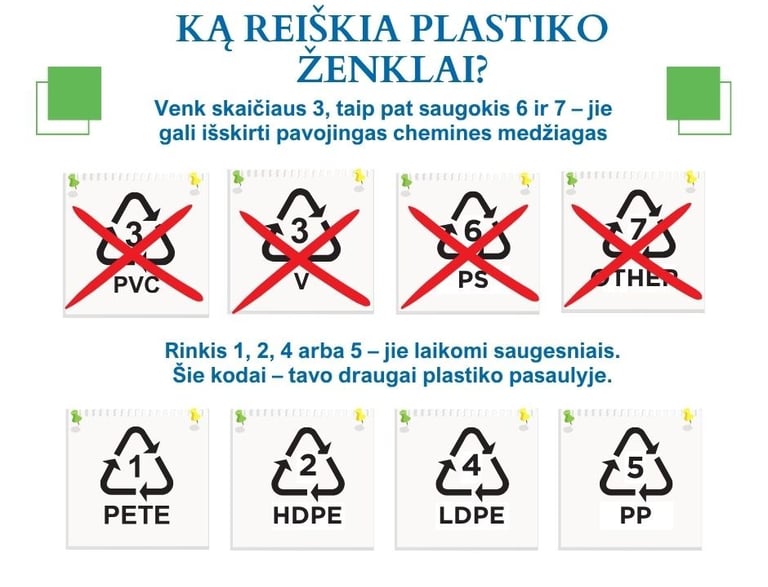

How do I recognise phthalates in household chemicals?
When we try to clean our homes, we often contaminate them even more. We use products that are supposed to be clean, but they also bring with them things we don't want: irritating chemicals, synthetic smells and sometimes phthalates. Cleanliness really doesn't need disinfection, aggressive ingredients or extra fragrance. Scent doesn't cleanse - it just hides.
Where do we start if we want to be free of unwanted compounds in our household?
First, the label. If a product is classified as hazardous, its packaging must bear special hazard symbols. Such products should only be used when strictly necessary - and exactly as intended.
Second is the composition. Avoid products whose labels say fragrance, parfum, aroma or simply fragrance. They often hide synthetic fragrance compounds, which can include phthalates. And fragrance, admittedly, has no cleansing power. It only creates the illusion of cleanliness. Air fresheners, detergent capsules, fabric softeners are among the most common sources of hidden odours (and phthalates).
Thirdly, certificates. Look for trusted environmental labels: EU Flower, Nordic Swan, Blue Angel, ECOCERT, ICEA. They show that a product meets stricter environmental and human friendliness criteria - which can mean a lower risk of exposure to phthalates.
And finally, air. The best air freshener is an open window. Fresh air fills the home with real, not synthetic, freshness and helps to cleanse the breathing environment of all the invisible but very real residues.
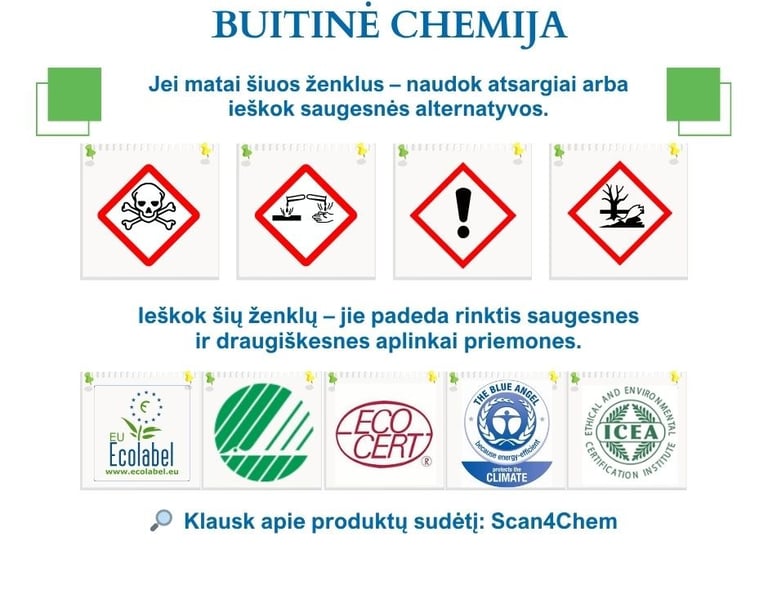

How do I recognise phthalates in cosmetics and personal care products?
And with cosmetics... I don't even know where to start. I myself have shelves full of shampoos, bath foams, lotions, face and body creams, sunscreen, toothpaste, wet wipes, deodorant... Packaging is full of ingredients. Small letters, long and confusing names. It's not so easy to understand what's really behind them.
Cosmetics can contain a wide range of dangerous substances, but for this article, let's focus on phthalates. They are used here to bind other ingredients together and help to keep the smell in check.
Where are they hiding? Most often, where the smell is. And usually named in a very unspecific way: fragrance, parfum, aroma, scent. Sometimes even more sophisticated names such as Musk Xylene, Musk Ketone, Cashmeran, Tonalide and other musk compounds.
Scents are added to almost everything: shampoos, lotions, face creams, deodorants, wet wipes... So if you want cosmetics without invisible "additives" that are bad for your health, you need to be more careful.
What to look out for?
Avoid products containing: fragrance, parfum, aroma, scent
Choose products with the shortest possible list of ingredients and more natural ingredients
Look for "phthalate-free", "fragrance-free"
Trust trusted eco-labels: COSMOS, Ecocert, ICEA, Cosmebio, BDIH
And if you still have doubts about the safety of your cosmetics, check here:
www.ewg.org/skindeep- A comprehensive database on cosmetic ingredient evaluation, with clear information on thousands of products.
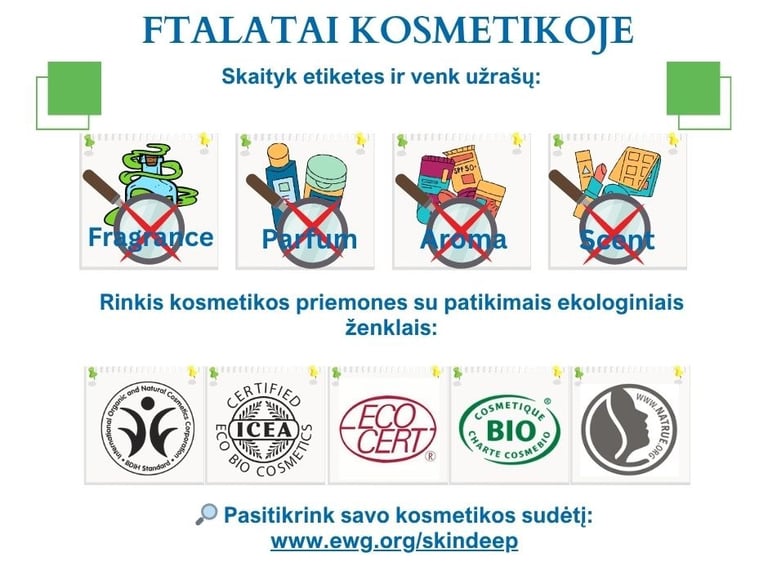

Phthalates in our homes
Home is our fortress. But even here there are dangers that we often let in ourselves. From plastic floor coverings and vinyl wallpaper, to wall paints, cables, shower curtains and mattress covers, they can all emit harmful chemicals, including phthalates.
What to look out for?
Avoid PVC coatings for floors, terraces, facades or flat roofs.
Avoid vinyl wallpaper, PVC/vinyl shower curtains, mattress protectors, plastic backed carpets and fabrics that may be treated with PFCs/PFAS
Caution with artificial fragrances: candles, air fresheners or home fragrances can hide phthalates under a sweet scent. If possible, choose natural fragrances or products labelled "phthalate-free".
Check for wires near the heater? If so, be sure to place them somewhere else where they are not exposed to heat. If cords and appliances are hot, harmful chemicals can be released.
Look for reliable certifications such as EPD International, M1, Nordic Swan, Blue Angel, EU Ecolabel, CE - these ensure that the product's lifecycle minimises the release of harmful substances into the environment.
As far as possible, give priority to natural materials: wood, wool, flax, hemp fibre, glass, ceramics, stainless steel, untreated wood.
And if you buy building materials - foams, paints, adhesives - don't forget to check their safety data sheets.
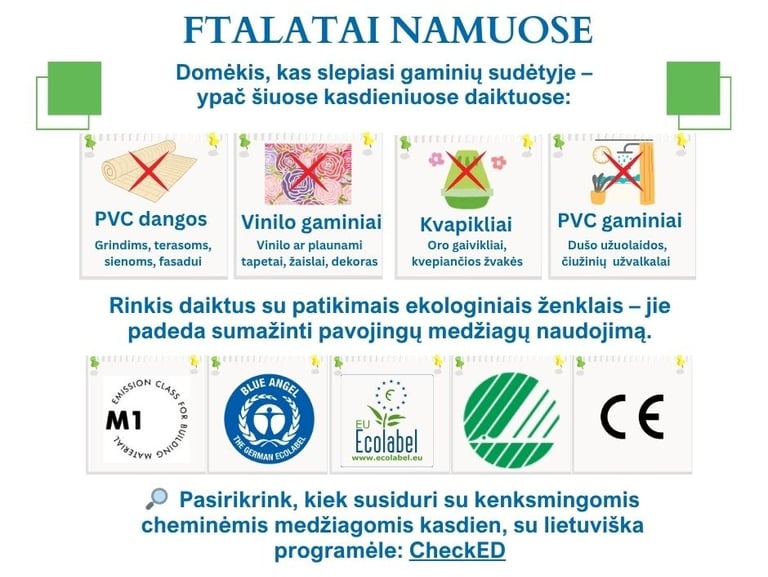

Textiles: the dangers of hiding in the cupboard
Have you ever thought that there could be a danger lurking in your favourite sweatshirt or bedding?
Even natural fibres such as cotton are often grown using pesticides. And both natural and synthetic fabrics are then dyed, glued or impregnated with chemicals that can pose health risks. Phthalates in textiles are mainly used as plasticisers to give elasticity to prints, appliqués or artificial leather.
What to look out for ?
· T-shirts, jumpers, children's clothing with rubber, embossed or glossy designs or lettering.
· Clothing with plastic appliqués, glitter, faux leather details or decorative films.
· Raincoats, overalls, jackets, especially if labelled as 'waterproof' - such products may use plasticisers including phthalates.
· Artificial leather products - handbags, shoes, belts - may use PVC (polyvinyl chloride), which often contains phthalates. These substances can leach out of both the surface and the lining, especially if the product is made from lower quality materials.
What can it do ?
· Avoid clothing with plastic prints or appliqués - choose natural fabrics without additional decoration.
· Choose textiles labelled OEKO-TEX® Standard 100, MADE IN GREEN by OEKO-TEX ®, Naturtextil BEST, GOTS (Global Organic Textile Standard), Ecolabel, Nordic Swan, PVC-free, phthalate-free
· And don't forget: new clothes, bedding or even soft toys need to be washed before use and aired after removal from the packaging, especially if there is a strong chemical smell.
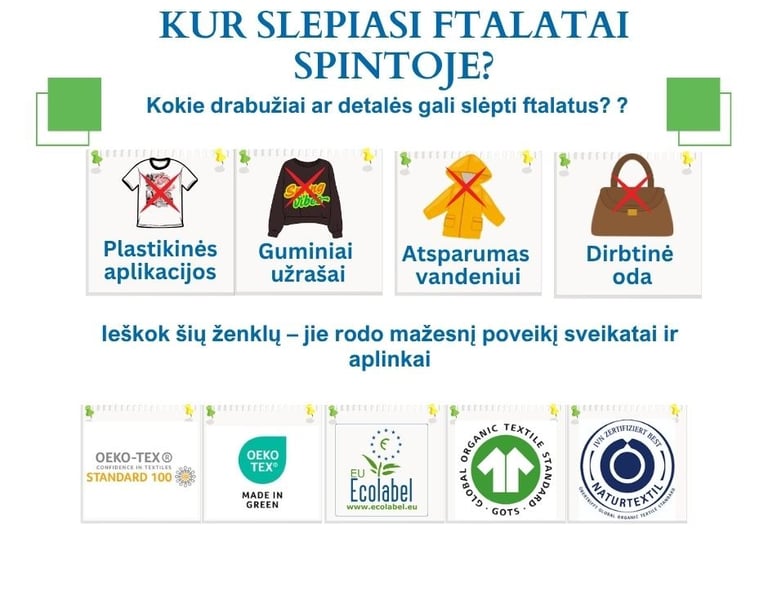

And finally, calmly, without panic
This text is not intended to cause fear. There is no need to give up pleasant smells, cleaning products or your favourite shower curtain in a hurry. Life is already full of risks - driving, drinking, lack of exercise or smoking are often much more of a health risk than a single candle in the bathroom.
The key is a sober attitude and responsible choices. Fortunately, today we have all the means to do so:
Responsible manufacturers make it clear if they do not use phthalates or other hazardous substances.
Many companies that work with integrity are also present in Lithuania. Even if they don't have official eco-certificates, they test their raw materials in laboratories and ensure the quality of their products.
You have the right to ask about the ingredients - and it's worth exercising that right!
Under EU law, manufacturers, importers and distributors have 45 days to provide information on hazardous substances if a customer asks for it.
To make it easier - use the free app:
Scan4Chem - sends requests to manufacturers with just a few clicks. You can download the app: Google Play https://bit.ly/3adYXs4 or App Store https://apple.co/388FpTk
What else can you do today?
Sometimes the healthier solutions are very simple:
Plant a Chlorophytum, a Sansevier or an Aloysius - they help clean the air in your home naturally.
After renovating or buying new furniture, open the windows to create a draft.
Don't use plastic utensils to heat your food and prefer natural materials.
Try the CheckED app - it helps you to assess the chemicals you are exposed to on a daily basis, including building and finishing materials.
Knowledge is power.
You don't have to be perfect - just start with one decision. And maybe the next time you're standing at the shelf, just ask yourself: is this choice good for me and the environment?
Thank you for reading, and if you liked this article, please share it with your friends.

Follow us
Biological wastewater treatment technology:
All rights reserved © 2025 Biocleaner.lt
Products:
